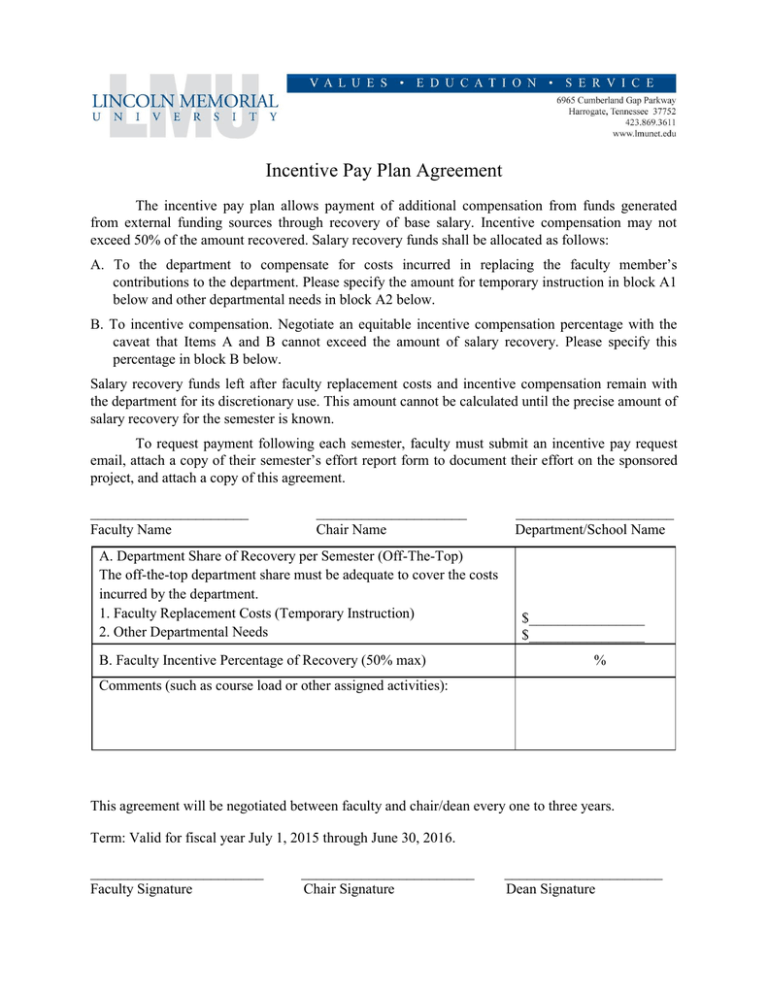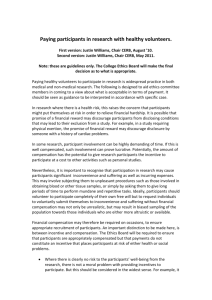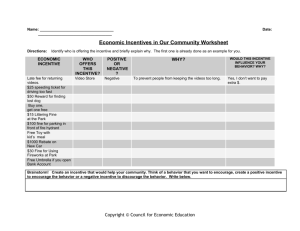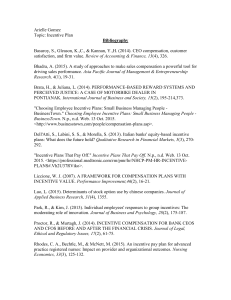Incentive Pay Plan Agreement
advertisement

Incentive Pay Plan Agreement The incentive pay plan allows payment of additional compensation from funds generated from external funding sources through recovery of base salary. Incentive compensation may not exceed 50% of the amount recovered. Salary recovery funds shall be allocated as follows: A. To the department to compensate for costs incurred in replacing the faculty member’s contributions to the department. Please specify the amount for temporary instruction in block A1 below and other departmental needs in block A2 below. B. To incentive compensation. Negotiate an equitable incentive compensation percentage with the caveat that Items A and B cannot exceed the amount of salary recovery. Please specify this percentage in block B below. Salary recovery funds left after faculty replacement costs and incentive compensation remain with the department for its discretionary use. This amount cannot be calculated until the precise amount of salary recovery for the semester is known. To request payment following each semester, faculty must submit an incentive pay request email, attach a copy of their semester’s effort report form to document their effort on the sponsored project, and attach a copy of this agreement. _____________________ Faculty Name ____________________ Chair Name A. A. Department Share of Recovery per Semester (Off-The-Top) The off-the-top department share must be adequate to cover the costs incurred by the department. 1. Faculty Replacement Costs (Temporary Instruction) 2. Other Departmental Needs B. Faculty Incentive Percentage of Recovery (50% max) _____________________ Department/School Name $________________ $________________ % Comments (such as course load or other assigned activities): This agreement will be negotiated between faculty and chair/dean every one to three years. Term: Valid for fiscal year July 1, 2015 through June 30, 2016. _______________________ Faculty Signature _______________________ Chair Signature _____________________ Dean Signature Incentive Pay Procedures: Overview: Faculty seeking incentive pay must obtain external funding for their base salary, negotiate an agreement with their chair and dean prior to submission of the grant application, verify work performed by signing the semester’s effort report form, and initiate payment by completing an incentive pay request email. Faculty Incentive Pay Plan Agreement: The purpose of this agreement is to create an understanding between faculty, chairs, and deans regarding the disposition of base salary budget recovered from external funding sources. 1. Before any incentive can be paid, the needs of the university must first be met. The most common need of the university is to employ a temporary instructor to replace faculty who receive a course release. The cost of temporary instruction should be specified in block A1 of the agreement. 2. At the discretion of the chair and dean, other situations may require additional funding for the department prior to paying the incentive to faculty. Any additional needs should be included in block A2. 3. Historically, the University has controlled 100% of the salary recoveries. With the advent of the incentive pay plan, 100% of these salary recoveries will be at the discretion of the deans and chairs. Chairs and deans are not required to pay the maximum incentive of 50% to the faculty. Rather, chairs and deans may negotiate incentive percentages less than 50% in order to meet department and college needs. Use block B to document the agreed upon incentive percentage. 4. The comment section should be used to document the expected course load or other assigned duties upon which the agreement was based. Incentive Pay Plan Purpose: The incentive pay plan seeks to reward faculty members with incentive pay equal to no more than 50% of the amount of salary ‘recovered’ from external funding sources. Background: In order to comply with federal cost principles in OMB Circular A-21, it is important that the cost to the external sponsor remain unchanged as a result of the incentive pay plan. In general, federal grants do not allow extra compensation to be direct charged. Thus, it is unallowable to direct charge incentive pay to a federal grant. Federal cost principles permit direct charging a percentage of base salary commensurate with the faculty’s level of effort on the federal grant. University funds ‘recovered’ by direct charging base salary to external funding sources can then be used for incentive pay provided that no Tennessee law is violated. Tennessee law limits the number of extra hours faculty are allowed to work and so extra compensation is limited by Tennessee law. In contrast, Tennessee law does not limit incentive pay because incentive pay requires no additional hours of work. Lincoln Memorial University’s incentive pay plan is based on the understanding and limitation that compensation exceeding the base salary will be derived from external funding sources. Incentive compensation is more money for the same work; extra compensation is more money for more work. Faculty may receive both incentive compensation and extra compensation if the situation warrants. Put another way, payment of extra compensation does not preclude the payment of incentive compensation. Situations will arise in which the external funding source can pay extra compensation or incentive compensation. Since incentive compensation is limited to 50% of the amount recovered, faculty may be able to receive more money by choosing extra compensation. However, this is appropriate only if more work is performed. Faculty receiving release time to work on the externally funded project should not receive extra compensation.






